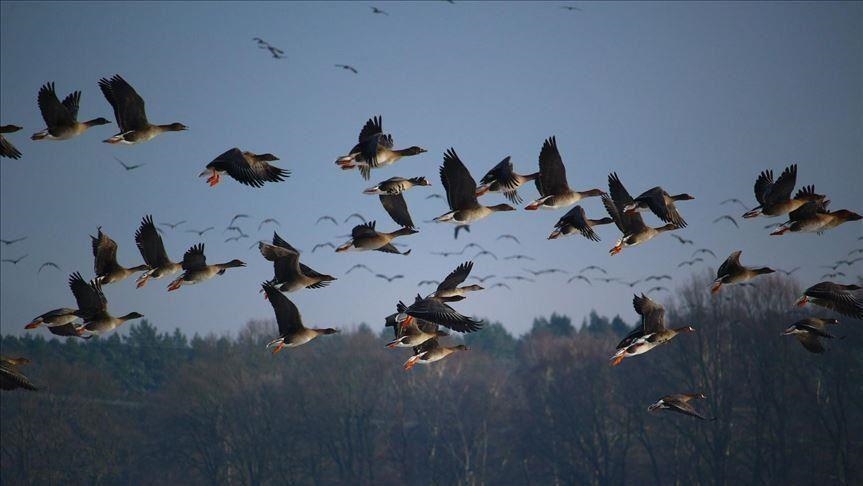Habitat loss endangers Tanzania’s migratory birds
Wetland provides important habitats to many bird species but is under threat from human-caused degradation
 File Photo
File Photo
KILOMBERO, Tanzania
Habitat loss in the sprawling Kilombero valley in the East African country of Tanzania has affected a sanctuary for the world’s migratory birds, posing an increasing peril to the long-distance fliers, local researchers have warned.
The wetland, which provides important habitats to many bird species, is under threat from human-caused degradation.
Pantaleo Munishi, a professor of ecosystems and conservation at the Sokoine University of Agriculture in Morogoro city, said recurring drought spells, unsustainable farming practices, and overgrazing in wetlands have pushed numerous bird species toward extinction.
“The growing human population in this valley has substantially reduced sources of food for birds and has created new challenges for other species too,” he told Anadolu Agency.
Because of the ongoing degradation, Munishi believed, many bird species native to Kilombero may be unable to cope with the dire situation and will become extinct within a decade.
The annual migration of birds is one of the world’s greatest natural wonders, yet the critical staging areas birds need to complete their journeys are degrading or disappearing completely, researchers warned.
Best ecological conditions
Birds fly all across the world in search of the ideal ecological conditions and habitat for breeding, feeding, and raising their offspring, and when these conditions become harsher for them to survive, they migrate to regions where conditions are better, Munishi said.
The Kilombero Valley, a Ramsar site that serves as an important habitat for birds to rest, feed, and breed during their annual migration circle, is becoming increasingly vulnerable to human population pressure, poor farming practices, and the recurring drought spells, experts said.
A Ramsar site is a wetland classified as having international significance under the Ramsar Convention established by UNESCO in 1971 that entered into force in 1975. It calls for national and international action to conserve wetlands and make intelligent, sustainable use of their resources.
The World Migratory Bird Day, observed in May, highlights the ecological threats that migratory birds face, as well as the need for global conservation action.
Many migratory birds, such as storks, cranes, eagles, and shorebirds, fly thousands of kilometers across countries and continents.
Experts say pressures from a growing human population, rapid urbanization, pollution, climate change, and unsustainable use of natural resources are causing the destruction and loss of natural habitats along the birds’ migration paths, threatening their very survival.
Halima Omari, an ecologist who manages parks in the valley, said there is an urgent need to protect migratory birds whose numbers are decreasing.
The beauty and behavior of these migratory birds captivate many people as they are a source of joy and an inspiration to many foreign tourists, she told Anadolu Agency.
The Kilombero Valley, as an important wetland, is home to a variety of animal and bird species. Its surrounding swamps act as habitats for fish, birds, hippos, and crocodiles.
The swamps are also home to unique species of birds, which are native to the area and plants, including freshwater mangroves.
Poisoning fishing
However, unsustainable fishing with poison, according to Munishi, has resulted in swamp degradation and a large loss of fish and other marine species.
“Bad farming practices in the area are responsible for the destruction of the largest feeding grounds for hundreds of thousands of migratory birds,” he said.
According to him, flocks of migratory birds traveling between Europe and Australia used to stop in the Kilombero Valley to eat fish and other delicacies, but such food is no longer available.
Munishi said the loss of those critical sites means that large flocks of migratory birds no longer have a place to rest and feed to regain badly needed energy for the journey, and many may die along the way.
“Many of these critical sites have been encroached by humans and livestock, the species are rapidly declining,” he told Anadolu Agency.
Munishi urged authorities to improve the management of existing protected sites and to coordinate conservation actions.
While the Kilombero wetland provides important habitats for many bird species, it has lately come under increasing threat from human-induced degradation.
As a wetland of international importance based on its significance to biodiversity, researchers said the area has been subjected to an increasing level of disturbance, scaring away rare migratory birds.
Environmental officials have acknowledged that the destruction in the valley has also caused major disruption to migratory birds native to Kilombero that have until recently proven more resilient to changing situations.
“The evidence strongly suggests that the population of highly endangered bird species is declining in Kilombero,” Munishi said.
Over the past few decades, populations of migratory birds that breed in temperate regions and during winter in the tropics have been subjected to many calcines.
BirdLife International's analysis of continent-wide survey data from 1970 to 2020 revealed this decline.
Over the 30-year study period, 48 out of 119 long-distance bird species that breed in Europe and during winter in Sub-Saharan Africa have shown substantial negative population trends.
“The government has the duty to protect the dwindling population of birds,” Munishi said.
Anadolu Agency website contains only a portion of the news stories offered to subscribers in the AA News Broadcasting System (HAS), and in summarized form. Please contact us for subscription options.




